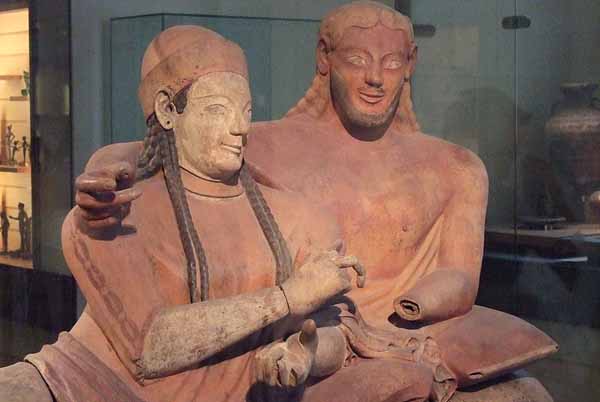The artistic and cultural height of the Etruscan civilization came in the 7th century B.C, during what is called by scholars the “Orientalizing Period”. The Orientalizing period is greatly characterized by and identified with the art and craftsmanship of the time, which saw huge influence from the art of the Greeks and Etruria’s Near Eastern neighbors like Egypt, Syria, and Palestine (though not as consistently or for as long).
Thanks to the richness of Italy’s terrain, metal was plentiful, and provided a great source of metal from which Greek craftsmen (who had settled in Etruria) could fashion such items as arms, jewelry, and everyday items, in addition to producing spectacular sculpture. The Etruscans learned the techniques of Greek art, and modified it to their own unique tastes, creating an unmistakable style that is known today as Etruscan art. This unique style denoted the wealth and luxury that many Etruscans were enjoying at the time.
It is during this period where we see the appearance of large-scale tombs that interred the bodies of the deceased Etruscans. It was no longer commonplace to cremate the dead. Tombs allowed for a more spectacular show of opulence, and a more comfortable afterlife. These tombs were housed in hollowed out mounds and contained lavish treasures that represented the fairly new aristocratic classes. The mounds were designed to copy the plan of a typical Etruscan home.
During the Orientalizing period, we find several other significant cultural developments that helped to cement the Etruscans’ place in ancient history:
- Hunting became a common and popular sport of the upper class.
- The Etruscans developed a sophisticated writing system during the early 7th century B.C. This writing system was directly influenced from early forms of Greek.
- The fortifications of cities became more common, as the increase of Etruscan wealth undoubtedly raised concerns of attacks and invasions.
- A system of complex roads was put into place throughout Etruria.
During this time, Etruria had begun to exert influence over all of Italy, including Rome. Etruria had embraced Greek culture, so Etruria’s influence was a sort of conglomeration of cultures. Aside from Greek art, the Etruscans were fascinated by and emulated Greek myth, ritual, sport, and even wine making.
By the 6th century B.C., Etruscan life was stringently ruled by the aristocratic classes. In the next installment of this series, we will see how that power begins to backfire on the Etruscans, and we will see glimpses that the end for them is in sight.








